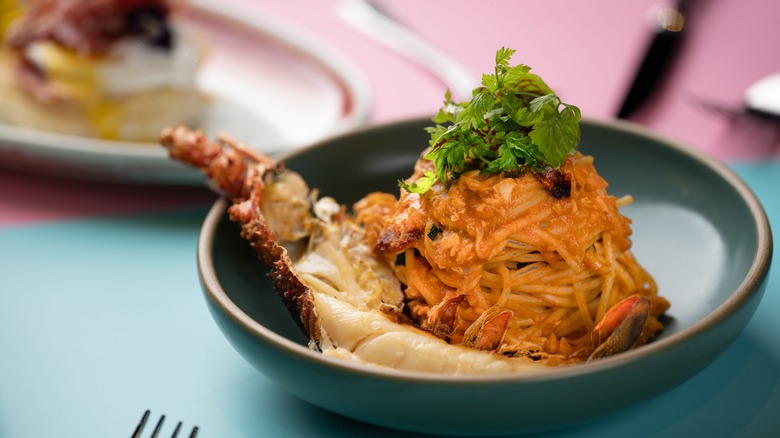Andrew Zimmern's Bisque Pasta Is The Easiest Way To Use Leftovers
Ah, bisque; at once ethereal and substantial. This velvety-smooth, creamy soup is the very essence of its ingredients. Usually that means shellfish, like this classic lobster version or crab, with the shells, normally culinary detritus, pan-seared to turn the flavor up to 11. But there are also vegetable-focused bisques, such as silky corn versions that are sweet and savory. Regardless of what soup you choose, these are, of course, sipped from a spoon. Maybe, though, there shouldn't be such a linear approach to enjoying bisques.
Let's posit that you've made a batch of bisque and the leftovers are mellowing in the fridge. You can't bring yourself to ignore the delicious concoction, but you just don't feel like another bowl. Chef Andrew Zimmern, the provocative gastronome from the Food Network, has a dandy solution that transforms bisque with just one simple ingredient addition: Pasta. Ask yourself, what is really separating a soup, especially a creamy one with loads of body, from being a pasta sauce? When used in the right ratio and maybe reduced a bit, bisque can easily coat noodles, leading to a rich and satisfying pasta that captures the essence of the original dish while also turning it on its head.
Simply combine for a satisfying meal
The first step to leftover bisque, clearly, is to make a bisque. While there are some fine pre-made bisques on the market, it's a relatively simple affair, so don't be intimidated by the prospect of making your own. This will allow you to adjust and add ingredients to build a flavor profile you love. If you decide to go with shellfish, remember that it isn't the meat you're after, but rather the shells. You can save the shells from shrimp you've used elsewhere, buy shellfish with the shells intact, or even ask your fishmonger if they can save you some shells. Similarly, if you decide to go for a corn bisque, you need to purchase corn on the cob. The inedible core has much to contribute to making a silky, intensely-flavored corn broth.
To make the pasta dish, transfer a small portion of your bisque to a sauce pan and reduce slightly over heat before adding in the cooked pasta. Andrew Zimmern suggests fettuccine, though pappardelle would work just as well. You'll want to give the al dente pasta a few minutes to mesh with the bisque and coat each strand. Do this over low heat so as not to scorch either the pasta or the bisque. When it comes to garnishes, you can keep it simple with a sprinkle of chopped chives and a bit of lemon zest or bulk things up with any reserved shellfish meat or corn kernels.

